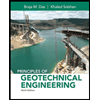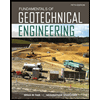
(a)
Find the change in effective stress
(a)
Answer to Problem 9.4P
The change in effective stress at point C when the water table drops by 2 m is
Explanation of Solution
Given information:
The thickness
The thickness
The thickness
The void ratio (e) of soil in the first layer is 0.7.
The specific gravity
The void ratio (e) of soil in the second layer is 0.55.
The depth (h) of water table drop is 2 m.
Calculation:
Determine the dry unit weight
Here,
Take the unit weight of the water as
Substitute 2.69 for
Determine the dry unit weight
Substitute 2.7 for
Determine the saturated unit weight
Substitute
Calculate the total stress at point C (13 m) using the relation.
Substitute
Calculate the pore water pressure at point C (13 m) using the relation.
Substitute
Calculate the effective stress at point C (13 m) using the relation.
Substitute
Water table drops by 2 m:
Calculate the total stress at point C when the water level drops by 2 m using the relation.
Substitute
Calculate the pore water pressure at point C when the water table drops by 2 m using the relation.
Substitute
Calculate the effective stress at point C when the water table drops by 2 m using the relation.
Substitute
Determine the change in effective stress when the water level drops by 2 m from the original position using the relation;
Substitute
Thus, the change in effective stress at point C when the water table drops by 2 m is
(b)
The change in effective stress
(b)
Answer to Problem 9.4P
The change in effective stress at point C rises to the surface up to point A is
Explanation of Solution
Given information:
The thickness
The thickness
The thickness
The void ratio (e) of soil in the first layer is 0.7.
The specific gravity
The void ratio (e) of soil in the second layer is 0.55.
Calculation:
Determine the saturated unit weight
Substitute
Calculate the total stress at point C (13 m) using the relation.
Substitute
Calculate the pore water pressure at point C (13 m) using the relation.
Substitute
Calculate the effective stress at point C (13 m) using the relation.
Substitute
Water table rises to the surface up to point A:
Determine the change in effective stress when the water table rises to the surface up to point A using the relation;
Substitute
Thus, the change in effective stress at point C rises to the surface up to point A is
(c)
Find the change in effective stress
(c)
Answer to Problem 9.4P
The change in effective stress at point C when the water level rises 3 m above point A due to flooding is
Explanation of Solution
Given information:
The thickness
The thickness
The thickness
The void ratio (e) of soil in the first layer is 0.7.
The specific gravity
The depth (h) of water rises above point A is 3.0 m.
Calculation:
Calculate the total stress at point C (16 m) using the relation.
Substitute
Calculate the pore water pressure at point C (16 m) using the relation.
Substitute
Calculate the effective stress at point C (16 m) using the relation.
Substitute
Water level rises 3 m above point A due to flooding:
Determine the change in effective stress when the water level rises 3 m above point A due to flooding using the relation;
Substitute
Thus, the change in effective stress at point C when the water level rises 3 m above point A due to flooding is
Want to see more full solutions like this?
Chapter 9 Solutions
PRINCIPLES OF GEOTECH.ENGINEERING >LL+M
- A tension member made of L4x4x1/2 is connected to gusset plate with welds. Using E70electrode and ½ inch weld size, design the balanced weld lengths.( Use AISC manual, LRFD units)(Previous solution was incorrect)arrow_forwardQ1: determine the area of steel for the slab that rests on brick walls and is shown in the figure. Use the following data: f'c = 25 MPa, fy = 420 MPa, L.L. = 1.5 kN/m², D.L. = 3 kN/m² (without self-weight). Rate from (1 to 4) your ability to solve the problem 7 m 0.3 m 0.3 marrow_forwardA rigging job calls for lifting a structure that weighs 150 tons. Two cranes are available, one with a rated capacity of 85 tons and the other with a rated capacity of 120 tons. The total weight of the rigging required to make the lift is 15 tons, of which 10 tons is to be carried by the larger craneand 5 tons is to be carried by the smaller crane. If the cranes are to be loaded in proportion to their net capacities, what should be the approximate net load on the 120-ton crane?arrow_forward
- I need detailed help solving this exercise from homework of Engineering Mathematics II.I do not really understand how to do, please do it step by step, not that long but clear. Thank you!P.S.: Please do not use AI, thanks!arrow_forwardI need detailed help solving this exercise from homework of Engineering Mathematics II.I do not really understand how to do, please do it step by step, not that long but clear. Thank you!P.S.: Please do not use AI, thanks!arrow_forwarda) For the truss shown in Fig 2, determine the stiffness matrices of elements 2, 3 and 4 in the in the global co-ordinate system. Assume for each member A = 0.0015 m2 and E = 200 GPa. Indicate the degrees-of freedom in all the stiffness matrices. b) Determine the stiffness matrix of the whole truss in the global co-ordinate system. Clearly indicate the degrees-of freedom numbers in the stiffness matrix. c) Calculate all the nodal displacements and all the member forces of the truss.arrow_forward
- I want an answer very quickly, pleasearrow_forwardI want an answer very quickly, pleasearrow_forwardQ1/ Choose the correct answer for the following: 1- Cantilever retaining walls is suitable for retaining backfill about a- 8m d-4m b- 12m c- 2m e- Any height 2-The shear key is provided to a- Avoid friction behind the wall d- All of the above b- Improve appearance e- None of the above c- Increase passive resistance types of retaining wall may b- Semi-gravity retaining walls d-Counterfort retaining walls be classified as follows: 3- The common a- Gravity retaining walls walls c- Cantilever retaining e- All the mentioned 4-Related to Stability of RW, Which of the following does not represent a potential failure mode for a retaining wall? a-Bearing capacity failure of the foundation soil. b- Wall cracking due to thermal expansion. c- Excessive settlement due to weak soil layer. d- Shear failure within the foundation soil adjacent to the wall. e-Sliding along the base due to insufficient friction. 5- If the desired factor of safety against sliding is not met, which strategy is NOT a…arrow_forward
 Principles of Foundation Engineering (MindTap Cou...Civil EngineeringISBN:9781305081550Author:Braja M. DasPublisher:Cengage Learning
Principles of Foundation Engineering (MindTap Cou...Civil EngineeringISBN:9781305081550Author:Braja M. DasPublisher:Cengage Learning Principles of Geotechnical Engineering (MindTap C...Civil EngineeringISBN:9781305970939Author:Braja M. Das, Khaled SobhanPublisher:Cengage Learning
Principles of Geotechnical Engineering (MindTap C...Civil EngineeringISBN:9781305970939Author:Braja M. Das, Khaled SobhanPublisher:Cengage Learning Principles of Foundation Engineering (MindTap Cou...Civil EngineeringISBN:9781337705028Author:Braja M. Das, Nagaratnam SivakuganPublisher:Cengage Learning
Principles of Foundation Engineering (MindTap Cou...Civil EngineeringISBN:9781337705028Author:Braja M. Das, Nagaratnam SivakuganPublisher:Cengage Learning Fundamentals of Geotechnical Engineering (MindTap...Civil EngineeringISBN:9781305635180Author:Braja M. Das, Nagaratnam SivakuganPublisher:Cengage Learning
Fundamentals of Geotechnical Engineering (MindTap...Civil EngineeringISBN:9781305635180Author:Braja M. Das, Nagaratnam SivakuganPublisher:Cengage Learning



